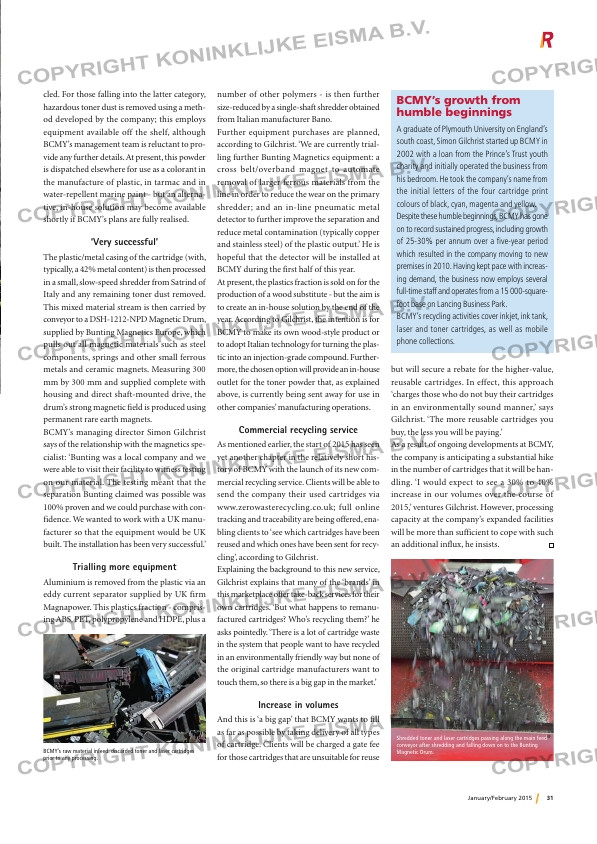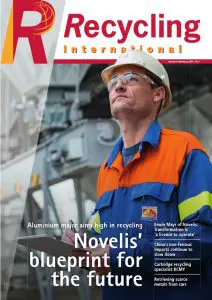Page 31 from: January / February 2015

31January/February 2015
cled. For those falling into the latter category,
hazardous toner dust is removed using a meth-
od developed by the company; this employs
equipment available off the shelf, although
BCMY’s management team is reluctant to pro-
vide any further details. At present, this powder
is dispatched elsewhere for use as a colorant in
the manufacture of plastic, in tarmac and in
water-repellent marine paint – but an alterna-
tive, in-house solution may become available
shortly if BCMY’s plans are fully realised.
‘Very successful’
The plastic/metal casing of the cartridge (with,
typically, a 42% metal content) is then processed
in a small, slow-speed shredder from Satrind of
Italy and any remaining toner dust removed.
This mixed material stream is then carried by
conveyor to a DSH-1212-NPD Magnetic Drum,
supplied by Bunting Magnetics Europe, which
pulls out all magnetic materials such as steel
components, springs and other small ferrous
metals and ceramic magnets. Measuring 300
mm by 300 mm and supplied complete with
housing and direct shaft-mounted drive, the
drum’s strong magnetic field is produced using
permanent rare earth magnets.
BCMY’s managing director Simon Gilchrist
says of the relationship with the magnetics spe-
cialist: ‘Bunting was a local company and we
were able to visit their facility to witness testing
on our material. The testing meant that the
separation Bunting claimed was possible was
100% proven and we could purchase with con-
fidence. We wanted to work with a UK manu-
facturer so that the equipment would be UK
built. The installation has been very successful.’
Trialling more equipment
Aluminium is removed from the plastic via an
eddy current separator supplied by UK firm
Magnapower. This plastics fraction – compris-
ing ABS, PET, polypropylene and HDPE, plus a
number of other polymers – is then further
size-reduced by a single-shaft shredder obtained
from Italian manufacturer Bano.
Further equipment purchases are planned,
according to Gilchrist. ‘We are currently trial-
ling further Bunting Magnetics equipment: a
cross belt/overband magnet to automate
removal of larger ferrous materials from the
line in order to reduce the wear on the primary
shredder; and an in-line pneumatic metal
detector to further improve the separation and
reduce metal contamination (typically copper
and stainless steel) of the plastic output.’ He is
hopeful that the detector will be installed at
BCMY during the first half of this year.
At present, the plastics fraction is sold on for the
production of a wood substitute – but the aim is
to create an in-house solution by the end of the
year. According to Gilchrist, the intention is for
BCMY to make its own wood-style product or
to adopt Italian technology for turning the plas-
tic into an injection-grade compound. Further-
more, the chosen option will provide an in-house
outlet for the toner powder that, as explained
above, is currently being sent away for use in
other companies’ manufacturing operations.
Commercial recycling service
As mentioned earlier, the start of 2015 has seen
yet another chapter in the relatively short his-
tory of BCMY with the launch of its new com-
mercial recycling service. Clients will be able to
send the company their used cartridges via
www.zerowasterecycling.co.uk; full online
tracking and traceability are being offered, ena-
bling clients to ‘see which cartridges have been
reused and which ones have been sent for recy-
cling’, according to Gilchrist.
Explaining the background to this new service,
Gilchrist explains that many of the ‘brands’ in
this marketplace offer take-back services for their
own cartridges. ‘But what happens to remanu-
factured cartridges? Who’s recycling them?’ he
asks pointedly. ‘There is a lot of cartridge waste
in the system that people want to have recycled
in an environmentally friendly way but none of
the original cartridge manufacturers want to
touch them, so there is a big gap in the market.’
Increase in volumes
And this is ‘a big gap’ that BCMY wants to fill
as far as possible by taking delivery of all types
of cartridge. Clients will be charged a gate fee
for those cartridges that are unsuitable for reuse
but will secure a rebate for the higher-value,
reusable cartridges. In effect, this approach
‘charges those who do not buy their cartridges
in an environmentally sound manner,’ says
Gilchrist. ‘The more reusable cartridges you
buy, the less you will be paying.’
As a result of ongoing developments at BCMY,
the company is anticipating a substantial hike
in the number of cartridges that it will be han-
dling. ‘I would expect to see a 30% to 40%
increase in our volumes over the course of
2015,’ ventures Gilchrist. However, processing
capacity at the company’s expanded facilities
will be more than sufficient to cope with such
an additional influx, he insists.
BCMY’s growth from
humble beginnings
A graduate of Plymouth University on England’s
south coast, Simon Gilchrist started up BCMY in
2002 with a loan from the Prince’s Trust youth
charity and initially operated the business from
his bedroom. He took the company’s name from
the initial letters of the four cartridge print
colours of black, cyan, magenta and yellow.
Despite these humble beginnings, BCMY has gone
on to record sustained progress, including growth
of 25-30% per annum over a five-year period
which resulted in the company moving to new
premises in 2010. Having kept pace with increas-
ing demand, the business now employs several
full-time staff and operates from a 15 000-square-
foot base on Lancing Business Park.
BCMY’s recycling activities cover inkjet, ink tank,
laser and toner cartridges, as well as mobile
phone collections.
BCMY’s raw material infeed: discarded toner and laser cartridges
prior to any processing.
Shredded toner and laser cartridges passing along the main feed
conveyor after shredding and falling down on to the Bunting
Magnetic Drum.
RI1_Bunting final.indd 31 22-01-15 12:38



